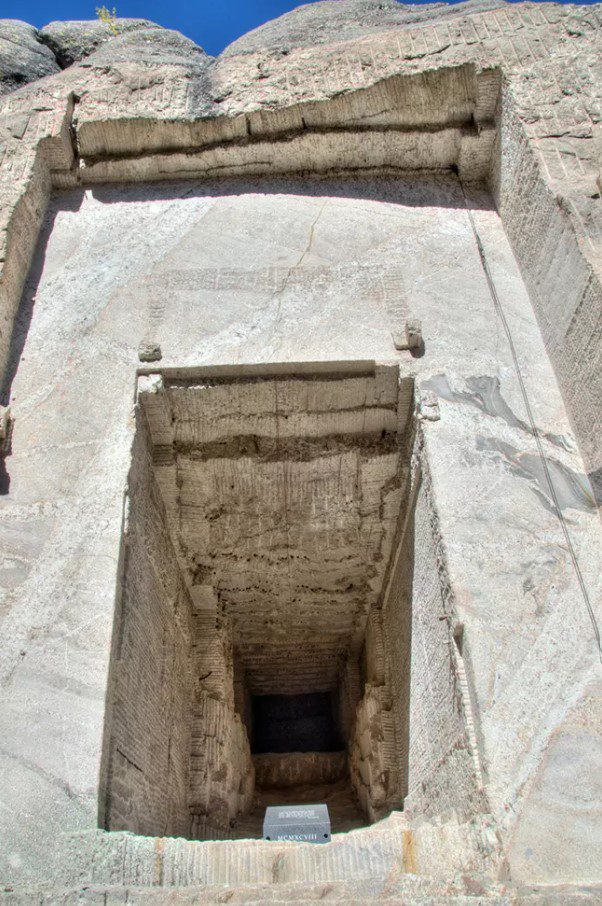On Halloween day 1941, the 14-year long effort to carve 18-meter (60-foot) tall faces into the side of Mount Rushmore was finally completed. Forming the iconic Mount Rushmore National Memorial in South Dakota, the structure displays the profiles of US presidents George Washington, Thomas Jefferson, Abraham Lincoln, and Theodore Roosevelt. But did you know behind these stoney facades sits an enormous incomplete hidden chamber?
Carved by Danish-American sculptor Gutzon Borglum, the faces making up the “Shrine of Democracy” were chosen to represent the nation’s birth, growth, development, and preservation.
The original plans, however, intended to include figures more relevant to the west, including Sioux chief Red Cloud. A leader of the Oglala Teton Dakota, Red Cloud fought to protect the western territories from US government efforts to build roads across Native American land between 1865 and 1867.
But after Borglum was assigned the role of lead sculptor, the plans were scrapped in favor of including figures with more national, as opposed to local, significance.
Suffragette Susan B. Anthony was also intended to be featured on the structure, to recognize her role in establishing equal voting rights for women through her formation of the National Woman Suffrage Association in 1869. However, these plans were also scrapped, as the bill proposing her inclusion came in too late after construction had already begun.
In addition to sculptural changes, Borglum had initially intended to carve a written description detailing the nine most important events in US history between 1776 and 1906 into the rockface surrounding the gargantuan sculptures. However, this plan too was scrapped after establishing how unfeasibly large the text would need to be to be legible from the ground.
Borglum instead decided to create a large room inside the structure called The Hall of Records, which would be accessible through a cavern at the back of the mountain. With the room measuring 24 by 30 meters (80 by 100 feet), he planned to erect a 243-meter (800-foot) granite staircase leading to a doorway 6 meters (20 feet) high and 4 meters (14 feet) wide carved into the outside rock.
At the entrance of the hall, a 12-meter (38-foot) bronze eagle was planned to sit above the door, along with the words “America’s Onward March”. The enormous room was intended to house glass cabinets containing the Constitution, the Declaration of Independence, and other historical documents.
Additionally, the room was to serve as his artist’s statement, allowing Borglum to detail the story and meaning behind his work. Borglum intended the chamber to be reserved for future civilizations, with the thought that the presently recognisable faces may one day become a mystery of forgotten origin.
These plans, however, never came to fruition. Following Borglum’s death in 1941, before the completion of the chamber, plans to continue the works were scrapped and the sculpture was instead declared complete in the same year.
The incomplete entrance to The Hall of Records. Image credit: NPS, Mount Rushmore National Memorial
The structure standing today is an inaccessible 5-meter (18-foot) doorway leading to a partially constructed 23-meter (75-foot) long empty room, with ceilings reaching 11 meters (35 feet).
Despite never finishing construction of the chamber, a repository of records was added to the Hall of Records’ door in 1998. Inside the repository, carved on porcelain enamel panels, is the story of how Mount Rushmore came to be, a brief history of the four featured presidents, a biography of the sculptor, and words from the Declaration of Independence.
Engraved on the capstone casing for the repository of records is Borglum’s quote:
“…let us place there, carved high, as close to heaven as we can, the words of our leaders, their faces, to show posterity what manner of men they were. Then breathe a prayer that these records will endure until the wind and rain alone shall wear them away.”
Source Link: What’s Inside Mount Rushmore’s Secret Chamber?
